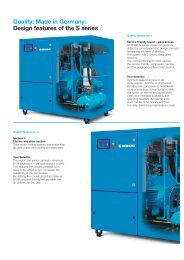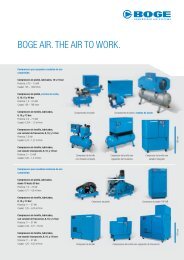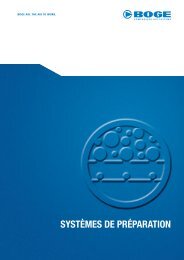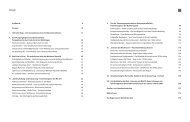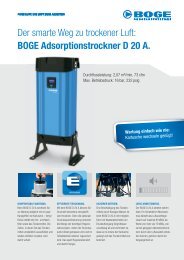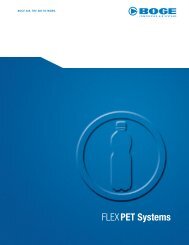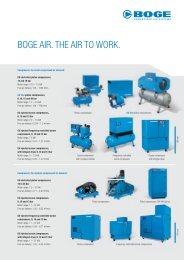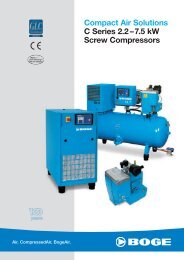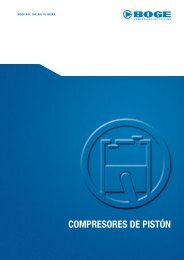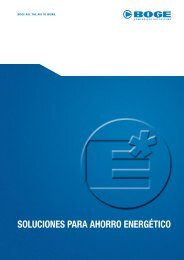Technical Paper Session Name: Energy ... - Boge Kompressoren
Technical Paper Session Name: Energy ... - Boge Kompressoren
Technical Paper Session Name: Energy ... - Boge Kompressoren
Create successful ePaper yourself
Turn your PDF publications into a flip-book with our unique Google optimized e-Paper software.
International Rotating Equipment Conference 2008, Düsseldorf<br />
The mentioned 32.9 % is a value which is, on average, applicable to all stations in the European<br />
Union. No matter what size the station is. But why is this big saving potential not used,<br />
especially in times like this, where energy costs are rising faster than ever before?<br />
One possible explanation is that in many industrial facilities compressed air costs are not<br />
evaluated in a transparent way. It is often very hard to find out the costs specifically used for the<br />
compressed air production, because the necessary data is not collected. If one does not know<br />
the total costs it is hard to figure the saving potential. Because the importance of the energy<br />
costs is not clear to all compressed air users this small calculation will highlight the significance:<br />
Calculation of cost factors<br />
The compressed air station in this example consists of a single, fixed speed 45 kW oil injected<br />
screw compressor operating 6,000 hours per year, with an idling time ratio of 33 %. Thus the<br />
compressor runs 4,000 h/a in load run and 2,000 h/a in idle run. This ratio is not very efficient,<br />
but it is quite common to installations of this kind.<br />
In this example we will calculate the three cost factors: a) energy, b) investment and c)<br />
maintenance costs.<br />
a) Calculation of energy costs<br />
The rated motor power of this compressor is 45 kW. This is the power available at the motor<br />
shaft. The power intake of the compressor, the value which has to be paid for, also includes the<br />
motor efficiency (estimated with 93 %) and the rated power including efficiency of the cooling<br />
fan motor (estimated with 0.7 kW and 70 %), which is also installed in compressors of this size.<br />
The power intake therefore results to: 45 kW / 93 % + 0.7 kW / 70 % = 49.4 kW. This is what the<br />
compressor uses during load run. During idle run the compressor usually uses about one third<br />
of this energy. This is the basis for our following energy calculation. The energy costs are<br />
estimated with 0.06 €/kWh.<br />
Costs for load run: 4,000 h/a x 49.4 kW x 0.06 €/kWh = 11,856 €/a<br />
Costs for idle run: 2,000 h/a x 49.4 kW / 3 x 0.06 €/kWh = 1,976 €/a<br />
Total energy costs: 13,832 €/a.<br />
b) Calculation of investment costs<br />
The purchase price of this example compressor is estimated at 14,000 €. With a linear<br />
depreciation over 7 years and 8 % interest rate the yearly costs for investment are roughly<br />
calculated with 14,000 € / 7 a x 1.08 = 2,160 €/a.<br />
c) Calculation of maintenance costs<br />
The compressor runs 6,000 hours per year. The total maintenance costs for an installation like<br />
this are roughly estimated with 1,200 €/a.<br />
Total costs<br />
Adding all three cost factors gives total annual costs for this compressor of 17,192 €. The<br />
13,832 €/a energy cost equates to 80 % of the total. Investment costs are only 13 % and<br />
maintenance costs only 7 % of the overall figure.<br />
The costs per m³ can now also easily be calculated. With a volume flow of 7 m³/min at 8 bar the<br />
compressor delivers 7 m³/min x 60 min/h x 4000 h/a = 1,680,000 m³/a. This results in cost per



